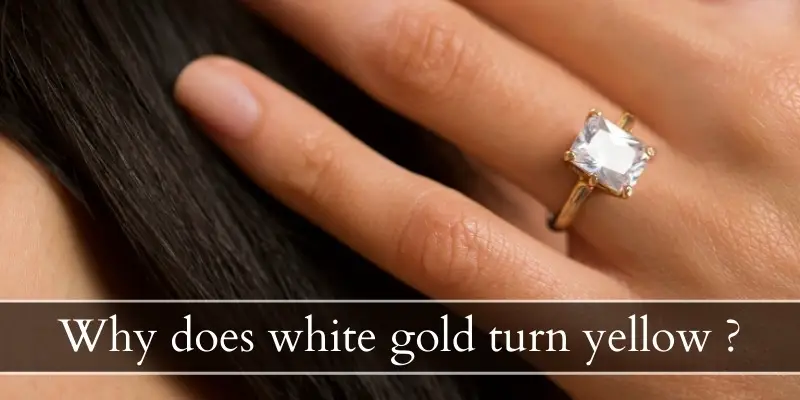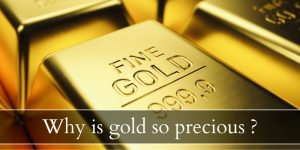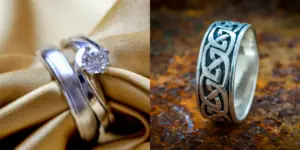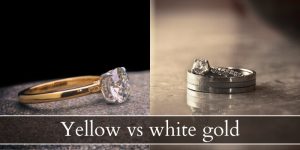A very modern metal for jewelry, especially engagement rings, is white gold. If you own at least one white gold jewelry piece you know how beautiful, bright, and shiny it is. And you also know how it can turn a bit yellow in time. Or perhaps you’ve just heard of this and want to know if this is really a good option for you.
So let’s discuss why white gold turns yellow in time, whether there’s anything you can do about it, and what other alternatives you have.

Why does white gold turn yellow ?
White gold turns yellow in time because its true color is pale yellow. It is the rhodium plating that gives white gold that bright white color. Once the rhodium wears off – through scratches or hitting objects – white gold’s real color will peek through. This is very difficult to avoid for jewelry that you wear daily, like rings and bracelets.
The name white gold may be misleading, in that its body color is not white, but pale gold. It was named white in comparison to its yellow gold counterpart. When you compare yellow gold to non-plated white gold, the white gold appears whiter, despite still having a distinctly golden shade.
How white gold is actually made
White gold is not truly white. This is because white gold, like all gold on the market, is an alloy of gold and another metal, in this specific case it is pure gold, zinc, and nickel. For example 18k white gold is 75% pure gold, 12.5% zinc and 12.5% nickel, while 14k white gold is only 55% pure gold and the rest is zinc and nickel.
The reason for this alloy is that pure gold is very, very soft and cannot be worn as-is. The jewelry would simply bend out of shape and scratch very easily. As for turning it white, pure gold is very deep, warm yellow, so it mush be mixed with white metals to appear as white gold. Sometimes the zinc or nickel are switched for palladium or platinum, but the end result is the same. A very pale gold color, almost white but not completely.
So, white gold always gets a rhodium plating. If you want yours without a rhodium plating, you can ask the jeweler if they can do this for you. The rhodium plating is there to offer that shining white finish, but it is not mandatory.
Read also: What Are Fancy Diamonds ?
Can you keep white gold from turning yellow ?
White gold is very difficult to keep from turning yellow, especially for pieces that are worn every day such as rings or bracelets. As you wear it, you hit it against other objects or other pieces of jewelry, and this leaves scratches that go through the rhodium and reveal the white gold beneath.
The only jewelry pieces that have a higher chance of keeping their rhodium plating indefinitely are earrings, and possibly pendants. These don’t see much rubbing or scratching, as they don’t hit anything.
So no, you can’t really avoid your white gold from turning yellow as the years go by, the same way you can’t keep silver jewelry from tarnishing, or any jewelry at all from scratching. But there are ways to fix this.
Thicker rhodium plating
The first option your have in keeping your white gold jewelry from turning yellow is to ask for a very thick rhodium plating. A plating (of any metal) is usually between 30 and 100 microinches, usually on the lower end for rhodium due to the high price. A thicker plating means that scratches have a smaller chance of going through the entire rhodium plating and revealing the white gold.
Think of it as wearing a light spring jacket vs a parka, and how effective they’d be against an average January day.
Be warned though, a thicker rhodium plating will be more expensive, even if your eyes cannot easily tell the difference. The difference between 30 and 99 microinches is not noticeable to the naked eye, but provides better color protection.
Read also: How Long Does Rhodium Plating Last ? Can You Remove It ?
Get pure platinum instead of white gold
Another option would be to skip white gold and go for solid platinum. This is more expensive upfront but in the long run you actually come out better. White gold needs re-plating every few years, which is a process that costs because the jeweler must:
- clean the jewelry
- strip the rhodium plating
- put a fresh, new plating on top of the now naked white gold
And then, you’re back to square one, where your jewelry will again yellow after a few years. Meanwhile, platinum remains pure white as it’s solid platinum and white all the way through.
If you go this route, you should be aware of a few key features of white gold vs platinum:
- platinum is more expensive per gram, so any jewelry made in platinum will end up costing more
- platinum is denser than white gold, so jewelry will cost even more as it will be heavier
- platinum is far more scratch resistant than any gold alloy, so it requires minimal care
Taking care of your white gold jewelry
White gold jewelry can still be very well maintained, if you take very good care of it. This doesn’t mean you should take it off and only wear it on occasion (though that helps), but you should be a bit careful with it. Here’s a few things you can do to prolong the lifespan of that bright, white coating on your jewelry.
Don’t scratch wear white gold to heavy manual labor
Like any piece of fine jewelry, white gold can get scratches. So, take it off when you know you will do some heavy chores, such as gardening, woodworking, handling metal tools, hand-washing dishes, or generally any work that gets your hands in contact with hard rough surfaces.
For those occasions you can get a dupe made of stainless steel, or tungsten. These metals are far more resilient than white gold and they’re lightweight.
Take white gold to be re-coated in rhodium every few years
Another option if to simply take your white gold jewelry to be re-coated every few years. While it does cost a bit, it’s not a fortune and you can usually pick up the jewelry in a few days, depending on how busy the jeweler is.
If you feel like changing things completely you can even have the white gold rhodium-free, to try that color. It’s a very pale gold, a sort of cross between silvery-white and gold. In some cases it can be a very beautiful color.

I’m the main author for jewelrymaterialguide.com. I started this site after we did tons of research before our wedding and noticed that there is information about rings, jewelry, and so on that is really hard to find on the internet.






